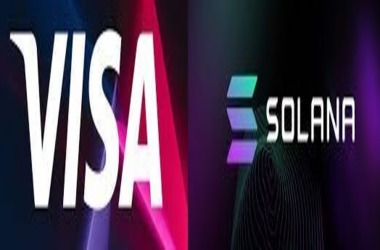
Cuy Sheffield, the Head of Crypto at Visa, emphasized the significance of this endeavor. He stated that by harnessing the potential of stablecoins such as USDC and leveraging the robust global blockchain networks of Solana and Ethereum, Visa aims to streamline cross-border settlements and offer a contemporary option for clients to seamlessly send and receive funds from Visa’s treasury.
This development has already had a notable impact on the cryptocurrency market, with Solana’s native token, SOL, surging by nearly 5% following the announcement. With a substantial market capitalization of $26 billion, USDC stands as the second-largest stablecoin in the crypto sphere.
Visa’s venture into the realm of cryptocurrency payments is not entirely new. Over two years ago, the financial services behemoth embarked on a pilot program, collaborating with Crypto.com to facilitate USDC transfers on the Ethereum blockchain. Building upon this experience, Visa has now partnered with prominent payment processing firms, Worldpay and Nuvei, to receive and settle transactions in USDC.
Visa highlighted the pivotal role these firms play in servicing an expanding array of merchants actively participating in the blockchain and cryptocurrency ecosystem. This includes on-ramp providers, gaming platforms, and NFT marketplaces, many of whom increasingly prefer to accept stablecoins over traditional fiat currencies for card payments.
Visa’s decision to incorporate Solana into its payment infrastructure represents a significant endorsement of the Solana blockchain. Previously, Visa had chosen Ethereum for its pilot program and introduced a recurring payments feature using Starknet, a scaling solution tailored for the Ethereum network, in the latter part of the previous year.
During the recent Starknet Summit, Cuy Sheffield expressed his optimism about stablecoins’ role in the evolving payment landscape. He emphasized the importance of representing dollars over blockchain networks and deemed it a substantial advancement in the field of digital payments.
“Two years ago, we had stablecoins, but most blockchains that existed two years ago didn’t really scale. We think that stablecoins, running through many different blockchains, are one of the most important and interesting innovations happening in payments today,” Sheffield stated.
In conclusion, Visa’s latest pilot program signifies a strategic shift towards embracing blockchain technology and cryptocurrencies as integral components of its payment ecosystem. By enabling merchants to accept USDC payments on the Solana blockchain, Visa is poised to enhance cross-border payment efficiency and provide clients with a modernized option for fund transfers. This move also marks a significant validation of the Solana blockchain’s capabilities and underscores Visa’s commitment to driving innovation in the payments industry.